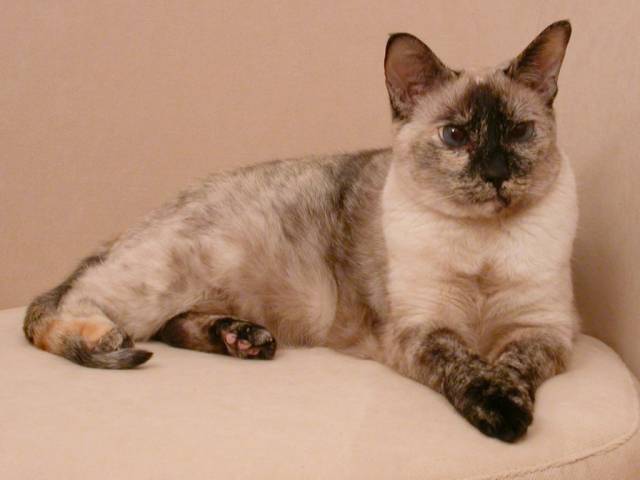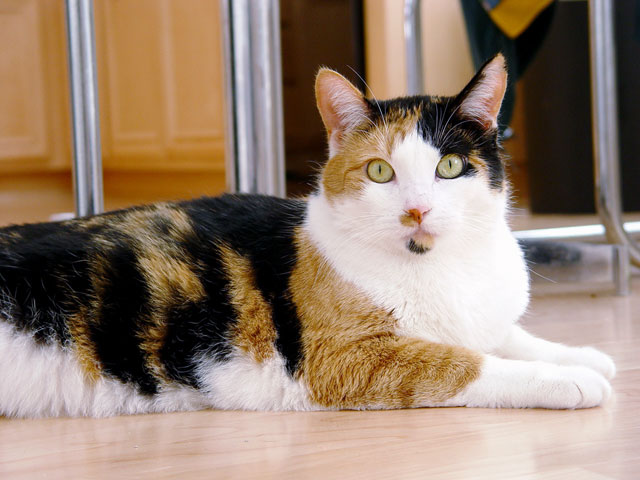Difference Between Tortie and Calico
What is Tortie and Calico?
“Calico” and “tortoiseshell” are the terms that signify pattern and color pattern of a cat’s fur coat. While all tortoiseshell cats are calico, not all calico cats are tortoiseshell cats. Though there is similarity in genetics of both the cats, the calico cats carry the white spotting allele. A tortoiseshell cat will have very tiny or no white color in her fur pattern.
Both torties and calicos are mostly females. Males are very rare. There is a 1 in 3,000 chance of both calico and Tortoiseshell cats being sterile due to an abnormality in the genes of both the cats. These have an extra X chromosome.
Tortie
The distinctive colors that make up a blend in the brindled coat in case of tortoiseshell cat include amber, red, chocolate, brown black, and cinnamon. Dilute tortoiseshell cats have faint colors like off-white and pale violet color, while one with ample black is termed as a chocolate tortoiseshell cat. A torbie has tortie colors associated with a tabby pattern. In the UK, what we call as a calico cat is called a tortie and white cat. Tortoiseshell cats come in both short and long hair varieties.
A torties cat can make up a great companion. These cats show a lot of attitude and are aggressive in nature.
Marzipan, one of the most famous tortoiseshell cats in the world, from Melbourne, Australia lived for longest 21 years. Torties are believed to bring luck to their owners.
Calico
Calico cats are considered to be very bold, lively and sassy. They possess a loving personality and a habitual liking and penchant for creating a trouble. A calico cat possesses a white coat with black and orange patches. A dilute calico possesses a softened to off-white, charcoal cream, and grey and light orange and same white base. Also, a calibby is a blend of a tabby and calico cat. Calibby and Calico has the same color variations, with an additional signature tabby stripe.
Calico cats are termed as “tortie-and-white”, “tricolor” or and “piebald” cats.
Difference between Tortie and Calico
Definition
Tortie
Tortoiseshell is a feline coat coloring. The name comes from tortoiseshell material. Tortoiseshell cats are awesome and beautiful creatures affectionally termed as “torties.” These are termed as “the divas of the cat world. These cats have some unique trait of showing attitude and that is termed as “tortitude”.
Calico
A calico cat fur coat is typically 25 percent to 75 percent white with large black and orange (in some cases off-white and grey patches).
It is either a full white cat with a less colored patches or a colored cat with a few white spots.
Color
Tortie
Torties or Tortoiseshell cats are commonly a blend of orange and black. Tortoiseshell cats do not always have dominant coloring and can be born with something called “dilute coloring” which simply means that the black and orange appear lighter on their fur.
Calico
A calico cat predominantly consists of 3 distinct colors (white is a must). Their coat has a definitive white with patches of orange (at times reddish brown or red) and black (at time grey or blue).
Breeds
Tortie
American shorthair, British shorthair, Cornish Rex, Persian, and Maine Coons
Calico
- Manx
- British Shorthair
- Arabian Mau
- Norwegian Forest Cat
- Turkish Angora
- Siberian
- Japanese Bobtail
- American Shorthair
- Turkish Van
- Exotic Shorthair
- Persian
Other names
Tortie
- Tortoiseshell
- Torbie
Calico
- Brindle
- Tri-color
- Tortoiseshell and white
- Lapjeskat – ‘patches cat’ in Dutch
- Tobi Mi-ke – ‘triple fur’ in Japanese
Attitude
Tortie
Strong-willed, a bit hot-tempered, very possessive of their human, fiercely independent, feisty and unpredictable.
Calico
Calico cats are more fiery, strong-willed, more temperamental than cats of the other color’s combinations within a breed, aggressive behaviors included swatting, hissing, and biting.
Summary
The points of difference between Tortie and Calico have been summarized as below:
- Difference Between Global Warming and Greenhouse Effect - May 18, 2024
- Difference Between Vaccination and Immunization - March 3, 2024
- Difference Between Selective Mutism and Autism - February 25, 2024
Search DifferenceBetween.net :
Leave a Response
References :
[0]Image credit: https://commons.wikimedia.org/wiki/File:Calico_cat_-_Phoebe.jpg
[1]Image credit: https://commons.wikimedia.org/wiki/File:Tortie-point.jpg
[2]CENTERWALL, W. R., & Benirschke, K. (1973). Male Tortoiseshell and Calico (TC) Cats: Animal models of sex chromosome mosaics, aneuploids, polyploids, and chimerics. Journal of Heredity, 64(5), 272-278.
[3]Centerwall, W. R. (1976). Calico and Tortie Males: A Riddle Solved. Cats Magazine, (June 1976), 10.
[4]Moran, C., Gillies, C. B., & Nicholas, F. W. (1984). Fertile male tortoiseshell cats: Mosaicism due to gene instability? Journal of Heredity, 75(5), 397-402.
[5]Stelow, E. A., Bain, M. J., & Kass, P. H. (2016). The relationship between coat color and aggressive behaviors in the domestic cat. Journal of applied animal welfare science, 19(1), 1-15.
[6]Todd, N. B. (1977). Cats and commerce. Scientific American, 237(5), 100-107.



